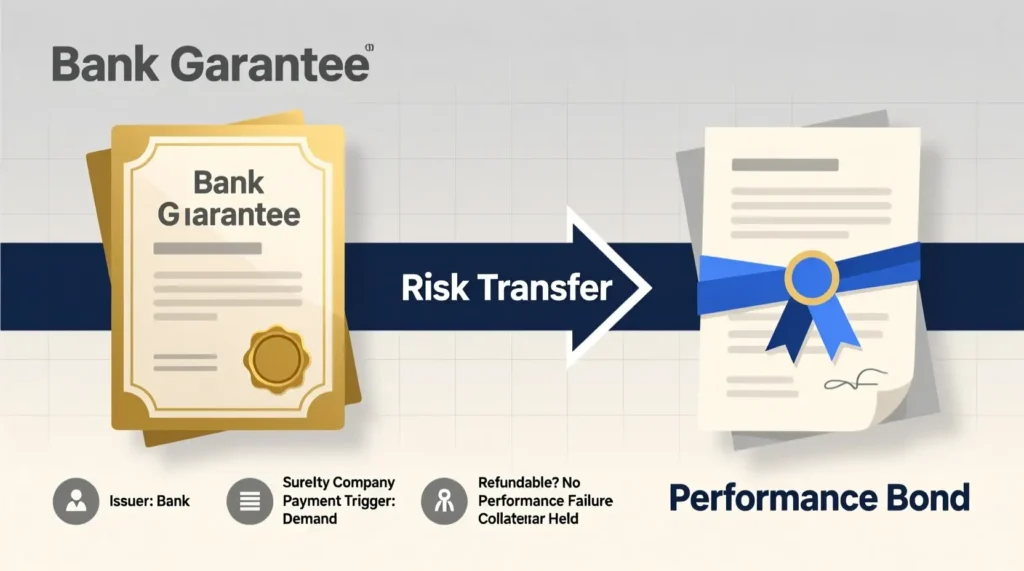Contract wranglers and deal-makers! If you’re knee-deep in construction gigs, big trades, or any project where “what if they flake?” keeps you up at night, you’ve probably bumped into bank guarantees and performance bonds. They’re like the trusty sidekicks in your financial toolkit—promising that everyone holds up their end without turning into a total mess. But which one’s right for your next hustle? Grab a coffee, and let’s chat through the differences in plain English. No suits or spreadsheets required.
First Off: What’s a Bank Guarantee?
Imagine you’re lending cash or services to someone sketchy. A bank guarantee is basically your bank’s pinky swear: “If they bail, we’ll cover it.” Issued straight from a bank, it kicks in if the other party defaults on payments or obligations. The cool (or scary) part? It’s often “on-demand”—meaning the beneficiary can just say “pay up” without proving the mess first. Think of it as a quick-draw financial parachute for importers, exporters, or anyone in trade finance where speed trumps drama.
Pros: Super straightforward to enforce, low hassle for the claimant. Cons: Banks charge a fee (usually 1-2% of the amount), and it’s tied to your creditworthiness—gotta have the dough to back it.
Now, Meet the Performance Bond
Flip the script to projects like building a bridge or wiring a skyscraper. A performance bond is your surety company’s vow that the contractor will actually finish the job (or else). It’s a three-way dance: You (the project owner), the contractor, and the bond issuer (often an insurer, but banks can play too). If the contractor ghosts or botches it, the bond covers costs to hire someone else or fix the fallout—but only after you show proof of the screw-up.
It’s huge in construction and government contracts, where “good enough” isn’t a vibe. Fun fact: These bad boys can run 1-3% of the project value in premiums, and they’re conditional— no pay-without-proof shenanigans.
Pros: Protects against real non-performance, not just vibes. Cons: More paperwork to claim, and if you’re the contractor, a weak credit score might jack up costs.
Head-to-Head: Bank Guarantee vs. Performance Bond Showdown
Alright, let’s cut the fluff with a quick side-by-side. (Because who has time for walls of text?)
| Aspect | Bank Guarantee | Performance Bond |
|---|---|---|
| Issuer | Mostly banks | Surety companies or banks |
| Trigger | On-demand (just ask, and pay!) | Conditional (prove the default first) |
| Main Use | Trade, loans, advance payments | Construction, big projects |
| Claim Process | Fast and furious—no proof needed | Slower, needs evidence of failure |
| Cost to You | 1-2% fee, based on your credit | 1-3% premium, tied to project risk |
| Risk Level | Higher for issuer (quick payout) | Shared—surety might step in to fix |
| Global Vibes | Common in international deals | Standard in U.S./UK contracts |
Bottom line? Guarantees are like cash on call for financial hiccups, while bonds are the project whisperer ensuring the work gets done right.
When Do You Pick One Over the Other?
Picture this: You’re exporting widgets to Europe. Snag a bank guarantee to lock in that advance payment—easy peasy, no construction crew required.
But if you’re bidding on a hospital build? Demand a performance bond from your contractor. It weeds out the flakes and saves you from mid-project nightmares (looking at you, endless delays).
Hybrid alert: Sometimes folks blend ’em— like a performance bond backed by a bank guarantee for extra oomph. And hey, in 2025, with supply chains still wonky post-pandemic, these tools are hotter than ever for dodging defaults.
Wrapping It Up: Your Move, Boss
Bank guarantees and performance bonds? Both are MVPs for keeping deals drama-free, but one’s your speedy financial fix, and the other’s your project bodyguard. Chat with your bank or surety buddy before diving in—tailor it to your risk appetite and contract deets. Got a wild story from the field or need more specifics? Hit the comments. Here’s to contracts that stick the landing, every time.



